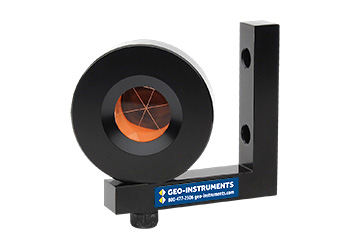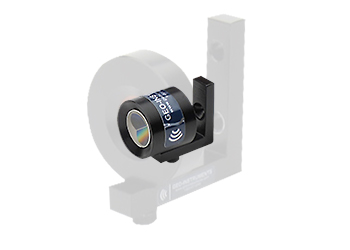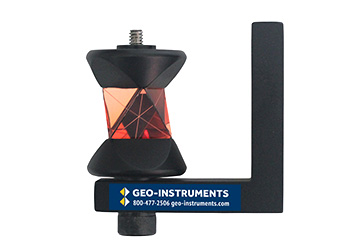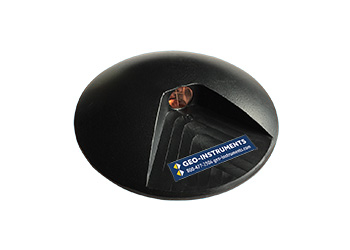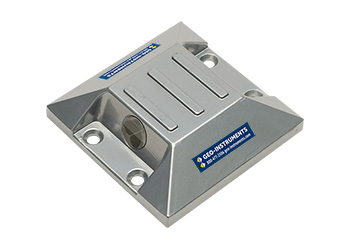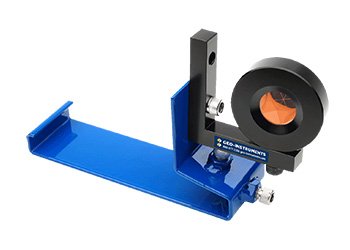Optical Survey Prisms
What are optical survey prisms?
Optical survey prisms, sometimes called "monitoring prisms" are glass reflectors used with total stations and AMTS monitoring systems.
Prisms reflect the infrared beam emitted by the total station, allowing it to calculate the precise distance to the prism and resolve the horizontal and vertical angles to the prism.
Prisms provide the strongest return when they are perfectly aligned to the lens of the AMTS. However, accurate measurements are still possible with misalignments of up to ± 10°.
How are survey prisms used?
In monitoring applications, survey prisms are installed at monitoring points and control points.
Monitoring points are specified locations on objects that are subject to displacement, such as soldier piles, buildings, retaining walls, road surfaces, and railroad tracks. Survey prisms at monitoring points provide settlement and displacement data.
Control points are stable locations outside the zone of influence. Survey prisms installed at control points are used to measure the position of the AMTS itself at every observation cycle.
L-Bar Prisms
L-Bar Mini Prism
The L-Bar Prism is installed on tunnel walls, building facades, foundation slabs, retaining walls, and almost any other location. The 25 mm diameter prism is used for both monitoring points and control points.
L-Bar Micro Prism
The L-Bar Micro Prism is a tiny prism designed for low visual impact and is nearly invisible in most environments. The 12.7 mm diameter prism is best used for indoor monitoring points.
L-Bar 360 Prism
The L-bar 360° prism has 6 triple prisms and can be targeted by two more AMTS systems as a monitoring point, a control point, or a tie-in point between separate AMTS.
Road Prisms
Polymer Road Prism
Road prisms are used to monitor settlement of roads, pavement, and other surfaces. The polymer road prism has a 10 mm prism with fixed angles of 10, 20, or 40 degrees.
HD Road Prism
The HD road prism has a heavy-duty, cast-aluminum housing made to withstand heavy traffic. The single prism and dual prism versions have 17 mm prisms fixed at 20 degrees.
Rail Prisms
Rail-Clip Prism
The Rail Clip is installed directly on the base of a rail and holds an L-Bar prism. The clip is available in 5.5 and 6 inch versions. Other versions can be installed in the ballast or on rail ties.
Installing and monitoring survey prisms
AMTS observation cycles are slowed by searching and retries that occur when the ATMS cannot find a particular prism or cannot obtain an adequate return from the prism. Performance can be optimized by careful placement of prisms and appropriate use of search windows and modes.
- Seek locations that keep sight lines between the AMTS and the prism free from possible interference, such as wire fences, building corners, reflective signage, and foliage.
- Install prisms in a way that provides as much angular separation as possible because lines of sight converge with distance.
- Set search windows no larger than necessary. The AMTS begins searches with its detection beam at full power and may incorrectly lock onto reflections from traffic cones, road signs, and other prisms if the window is too wide.
- Set the appropriate search mode. When possible, use a mode that searches for expected shapes of the prism (circles or 360). If shapes cannot be resolved, use a mode that seeks hotspots in the return signal.
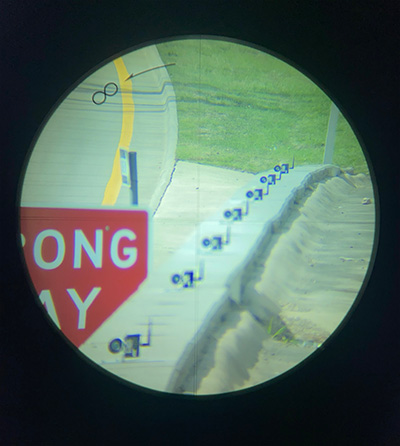
This AMTS view of prisms illustrates how lines of sight converge with distance. (prism/tiltmeter combos)

